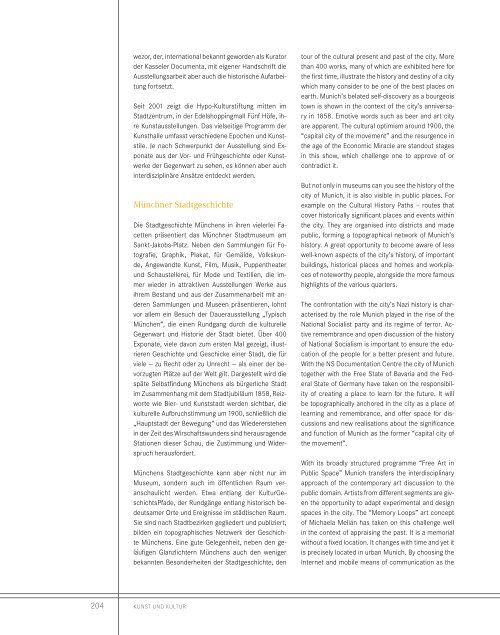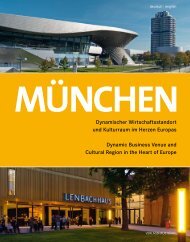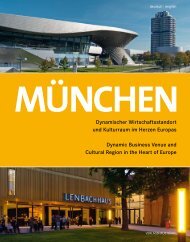Buch_Muenchen
You also want an ePaper? Increase the reach of your titles
YUMPU automatically turns print PDFs into web optimized ePapers that Google loves.
wezor, der, international bekannt geworden als Kurator<br />
der Kasseler Documenta, mit eigener Handschrift die<br />
Ausstellungsarbeit aber auch die historische Aufarbeitung<br />
fortsetzt.<br />
Seit 2001 zeigt die Hypo-Kulturstiftung mitten im<br />
Stadtzentrum, in der Edelshoppingmall Fünf Höfe, ihre<br />
Kunstausstellungen. Das vielseitige Programm der<br />
Kunsthalle umfasst verschiedene Epochen und Kunststile.<br />
Je nach Schwerpunkt der Ausstellung sind Exponate<br />
aus der Vor- und Frühgeschichte oder Kunstwerke<br />
der Gegenwart zu sehen, es können aber auch<br />
interdisziplinäre Ansätze entdeckt werden.<br />
Münchner Stadtgeschichte<br />
Die Stadtgeschichte Münchens in ihren vielerlei Facetten<br />
präsentiert das Münchner Stadtmuseum am<br />
Sankt-Jakobs-Platz. Neben den Sammlungen für Fotografie,<br />
Graphik, Plakat, für Gemälde, Volkskunde,<br />
Angewandte Kunst, Film, Musik, Puppentheater<br />
und Schaustellerei, für Mode und Textilien, die immer<br />
wieder in attraktiven Ausstellungen Werke aus<br />
ihrem Bestand und aus der Zusammenarbeit mit anderen<br />
Sammlungen und Museen präsentieren, lohnt<br />
vor allem ein Besuch der Dauerausstellung „Typisch<br />
München“, die einen Rundgang durch die kulturelle<br />
Gegenwart und Historie der Stadt bietet. Über 400<br />
Exponate, viele davon zum ersten Mal gezeigt, illustrieren<br />
Geschichte und Geschicke einer Stadt, die für<br />
viele -- zu Recht oder zu Unrecht -- als einer der bevorzugten<br />
Plätze auf der Welt gilt. Dargestellt wird die<br />
späte Selbstfindung Münchens als bürgerliche Stadt<br />
im Zusammenhang mit dem Stadtjubiläum 1858, Reizworte<br />
wie Bier- und Kunststadt werden sichtbar, die<br />
kulturelle Aufbruchstimmung um 1900, schließlich die<br />
„Hauptstadt der Bewegung“ und das Wiedererstehen<br />
in der Zeit des Wirschaftswunders sind herausragende<br />
Stationen dieser Schau, die Zustimmung und Widerspruch<br />
herausfordert.<br />
Münchens Stadtgeschichte kann aber nicht nur im<br />
Museum, sondern auch im öffentlichen Raum veranschaulicht<br />
werden. Etwa entlang der KulturGeschichtsPfade,<br />
der Rundgänge entlang historisch bedeutsamer<br />
Orte und Ereignisse im städtischen Raum.<br />
Sie sind nach Stadtbezirken gegliedert und publiziert,<br />
bilden ein topographisches Netzwerk der Geschichte<br />
Münchens. Eine gute Gelegenheit, neben den geläufigen<br />
Glanzlichtern Münchens auch den weniger<br />
bekannten Besonderheiten der Stadtgeschichte, den<br />
tour of the cultural present and past of the city. More<br />
than 400 works, many of which are exhibited here for<br />
the first time, illustrate the history and destiny of a city<br />
which many consider to be one of the best places on<br />
earth. Munich’s belated self-discovery as a bourgeois<br />
town is shown in the context of the city’s anniversary<br />
in 1858. Emotive words such as beer and art city<br />
are apparent. The cultural optimism around 1900, the<br />
“capital city of the movement” and the resurgence in<br />
the age of the Economic Miracle are standout stages<br />
in this show, which challenge one to approve of or<br />
contradict it.<br />
But not only in museums can you see the history of the<br />
city of Munich, it is also visible in public places. For<br />
example on the Cultural History Paths – routes that<br />
cover historically significant places and events within<br />
the city. They are organised into districts and made<br />
public, forming a topographical network of Munich’s<br />
history. A great opportunity to become aware of less<br />
well-known aspects of the city’s history, of important<br />
buildings, historical places and homes and workplaces<br />
of noteworthy people, alongside the more famous<br />
highlights of the various quarters.<br />
The confrontation with the city’s Nazi history is characterised<br />
by the role Munich played in the rise of the<br />
National Socialist party and its regime of terror. Active<br />
remembrance and open discussion of the history<br />
of National Socialism is important to ensure the education<br />
of the people for a better present and future.<br />
With the NS Documentation Centre the city of Munich<br />
together with the Free State of Bavaria and the Federal<br />
State of Germany have taken on the responsibility<br />
of creating a place to learn for the future. It will<br />
be topographically anchored in the city as a place of<br />
learning and remembrance, and offer space for discussions<br />
and new realisations about the significance<br />
and function of Munich as the former “capital city of<br />
the movement”.<br />
With its broadly structured programme “Free Art in<br />
Public Space” Munich transfers the interdisciplinary<br />
approach of the contemporary art discussion to the<br />
public domain. Artists from different segments are given<br />
the opportunity to adapt experimental and design<br />
spaces in the city. The “Memory Loops” art concept<br />
of Michaela Melián has taken on this challenge well<br />
in the context of appraising the past. It is a memorial<br />
without a fixed location. It changes with time and yet it<br />
is precisely located in urban Munich. By choosing the<br />
Internet and mobile means of communication as the<br />
204<br />
Kunst und Kultur




